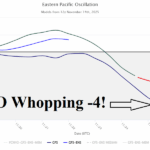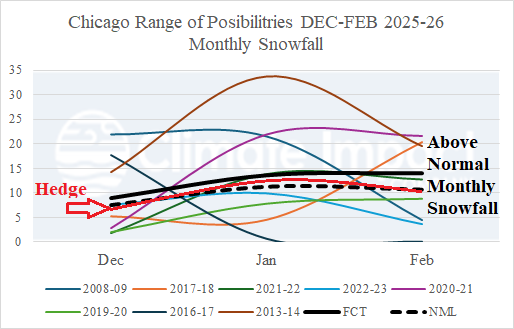
Is 12Z GFS Arctic Air 11-15-day Period U.S. Forecast Real?
11/14/2025, 12:49 pm EST
Climate Impact Company Daily Feature
Issued: Monday, November 17, 2025
Highlight: Chicago, IL and Boston, MA winter 2025-26 snowfall forecast. Large spread in analogs, especially mid-winter. Snowier than normal consensus.

Fig. 1: CIC-CA meteorological winter 2025-26 Chicago snowfall forecast.

Fig. 2: CIC-CA meteorological winter 2025-26 Boston snowfall forecast.
Discussion: The Chicago and Boston meteorological winter 2025-26 monthly snowfall forecast is based on a sea surface temperature anomaly (SSTA) analog considering both North Pacific and North Atlantic basins plus the El Nino southern oscillation (ENSO) regime. Thematic is the influence of persistent anomalous warmth of the middle latitudes of each ocean basin, the North Atlantic warm hole (NAWH) south of Greenland, and weak La Nina presence. An above normal risk of sudden stratospheric warming (SSW) events is present for the winter 2025-26 season due to the shift of the quasi-biennial oscillation (QBO) to the easterly phase.
The projected SSTA regime and SSW risk are found in 7 different analog years in the modern climate era (since the mid-to-late 1990’s). Each year has an assigned statistical weight based on the strength of the analog. The consensus of the analog years yields an above normal snowfall each month of meteorological winter 2025-26 in Chicago and Boston (except for February).
In Chicago, the analog years have a tendency for very snowy or not much snow during December with the consensus above the 30-year normal (Fig. 1). The wide variation in (analog) forecast solutions indicates below average forecast confidence. Similarly, the January analogs vary widely featuring 3 extremely snowy mid-winter scenarios while 2 (analogs) indicate very little snowfall. Once again, the consensus of analogs is above normal snowfall but with below average forecast confidence. In February, the wide spread of possibilities narrows slightly, and the consensus remains above normal snowfall and below average forecast confidence.
In Boston the December forecast is reasonably confident that near normal snowfall occurs based on 3 analogs slightly above normal snowfall and 3 analogs below normal snowfall (Fig. 2). The month of January yields high variance ranging from 2 inches to 35 inches. The consensus is a snowy mid-winter with below average forecast confidence. Forecast confidence increases in February favoring slightly below normal snowfall.
Given the accelerated warming of the mid-latitude oceans and influence on climate during the past decade, the most recent analog years are the “hedge”. The “hedge” analogs are less snowy, averaging near to slightly below normal snowfall for each month at each location.
Summary: Snowfall (and snow cover) are paramount to cold air mass support. Sustaining snow cover also vastly increases the risk of colder than normal temperatures. Chicago and Boston are forecast snowier than normal for winter 2025-26 although forecast confidence is below average. There is a near equal risk of significant snow or lack of snow during January for each location. The (more) recent analogs used as a “hedge” due to warmer ocean influence on climate favor near to slightly below normal snowfall for each location during the winter season.
